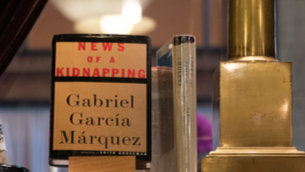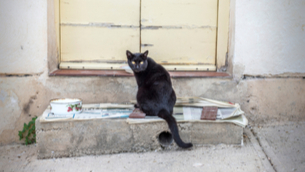| Ceci: | For the record, I’m still not convinced that this is going to work. |
| Rylan: | Oh, relax, Ceci! At the very least it’s going to be fun. And more importantly, it’s going to be different! |
| Ceci: | Pero, ¿por qué? Why? That’s what is still a little unclear to me, Rylan. Why does it need to be different? What’s wrong with a traditional approach to language learning? |
| Rylan: | Well that’s what this first episode is about. |
| Ceci: | Episode? |
| Rylan: | That’s right, our listeners will be with us every step of the way on this journey. |
| Ceci: | Wait, are we already recording? |
| Rylan: | Isn’t it exciting?! Welcome, everyone, to GUTS! … Did you like the music? I composed it myself! |
| Ceci: | I was under the impression that we were just going to talk… brainstorm about this little project of yours, this… |
| Rylan: | GUTS! |
| Ceci: | Right, right… “Guts”... what does that mean again? |
| Rylan: | Get. Up. To. Speed….in Spanish! |
| Ceci: | Ha! Cute… But “get up to speed” for what, exactly? |
| Rylan: | To learn! Or rather, to continue learning. It’s like a primer, a way to refresh and solidify some basics so that someone can keep going comfortably and confidently, on their language learning journey! In fact, after today’s lesson, we promise you. Yes, PROMISE you that you will be able to understand an entire paragraph in Spanish. Not only that, but we’ll show you more than 500 Spanish words that you already know! Sound impossible? |
| Ceci: | It does actually. |
| Rylan: | Hear me out. |
| Ceci: | OK, so it’s a beginners course? |
| Rylan: | Not exactly… Think of all those people who have tried learning Spanish in the past but for whatever reason they stopped. Over time, without practice, they forget some things, though not everything. |
| Ceci: | People who are not quite beginners? |
| Rylan: | Yes! They might be too advanced for a typical beginner's class, but might get lost in an intermediate level class. What do you say to those people? |
| Ceci: | You need to go back to the basics. You can’t just skip the beginning... |
| Rylan: | Ah! Not skip... Review! Refresh! Get up to speed! |
| Ceci: | Alright, I get it. It’s a nice sentiment, really, but - and this is why I was so intrigued in the first place - when you first invited me, you said that you wanted to help people learn Spanish without the usual methods of studying, drilling, and testing. |
| Rylan: | ¡Correcto! |
| Ceci: | That’s where you lose me, Rylan. As a linguist, you should know that these methods exist for a reason. They work! |
| Rylan: | But not for everyone! C’mon, you’re a teacher, you have met your share of frustrated students, people who drop out, who are looking for something... something different. |
| Ceci: | And that is GUTS? |
| Rylan: | It will be. I have a vision, Ceci. |
| Ceci: | You are really committed to this, aren’t you? |
| Rylan: | 100% |
| Ceci: | Why? |
| Rylan: | Well, I was one of those people. I tried and failed to learn Spanish multiple times. I was bored and unmotivated in the classroom, so you know what I did? |
| Ceci: | Well you should have come to me… |
| Rylan: | I packed my bags and headed to Latinoamérica! I traveled through as many countries as I could, from México to Argentina. Experiencing that part of the world was my motivation. I wanted, no, needed to learn Spanish as much and as quickly as possible. |
| Ceci: | So instead of taking a class and following a textbook, in a way, the people of Latin America became your teachers and the places you visited were your classroom. |
| Rylan: | Yeah, that’s a great way to describe it. And then… |
| Ceci: | Rylan, immersion is a wonderful way to learn a language. No question! But not everybody has the time or means to disappear for a year to learn Spanish. |
| Rylan: | Of course not, and that’s what GUTS is for! |
| Ceci: | Alright... (I already paid for parking…) Convince me. How are you going to do it? How are you going to “simulate immersion”? |
| Rylan: | Well, that’s what I’ve been working on with the team here at News in Slow… In a nutshell: We’re going to motivate our listeners with a fascinating story that grows along with their skill level. We’re going to pair that with stimulating conversations that explore the basic concepts which will prepare them for each chapter of the story. |
| Ceci: | So these “conversations”... They are the grammar lessons? |
| Rylan: | You could say that, but not like any grammar lesson you’ve had in the past. Our objective is to cover the basics, and to connect the grammar with something memorable - cultura, literatura, música, historia… |
| Ceci: | Hmmm... |
| Rylan: | All the while, never overwhelming or boring anyone with unnecessary lists or exhaustive exercises. We’ll tell fascinating stories that motivate our listeners to absorb and retain the knowledge which will unlock the next chapter! Just like my adventures did for me in Latin America. |
| Ceci: | That sounds great. Let’s see it. |
| Rylan: | You’re looking at it. |
| Ceci: | What? |
| Rylan: | You and me. We are going to create it! |
| Ceci: | You mean GUTS doesn’t exist yet?! |
| Rylan: | Don’t panic! We’ve done the research. We already have a unique story to draw in our listeners. All we need now is a co-host, someone to provide checks and balances. Look Ceci, we may disagree along the way, but with our years of experience combined we are bound to have an interesting conversation which will capture the essence of immersion! |
| Ceci: | Let’s say I agree to join this venture. Where would we start? |
| Rylan: | Cognates! |
| Ceci: | Cognates? |
| Rylan: | Words that look and sound the same across languages. |
| Ceci: | No, I know what a cognate is! What do you want to do with them? |
| Rylan: | Maximize their potential! When I was traveling I’d read books, watch movies, talk to people. Of course, at first there were big gaps in my understanding, but then I started to identify a few simple patterns. Suddenly I had this substantial vocabulary at my disposal, and the funny thing is that it had been there all along. Quickly, I realized I knew more Spanish than I thought! |
| Ceci: | There are thousands of words in Spanish that look and sound just like English words. All you have to do is know what to look for. |
| Rylan: | ¡Cognates! |
| Ceci: | Yes, they are a valuable tool, but there is much more to master than vocabulary. |
| Rylan: | That’s true! Cognates are just an anchor, or a solid foundation. We will build on top of them. |
| Ceci: | Go ahead then, show us what you can do with cognates. |
| Rylan: | Ok, let’s jump right in. As you probably already know, Spanish is derived from Latin... |
| Ceci: | And English has over 20,000 words “borrowed” from Latin. |
| Rylan: | That’s right, over 20,000 words that are reasonably comprehensible between the two languages. |
| Ceci: | That’s a lot of cognates. |
| Rylan: | By observing a few patterns, we can use them to build a bridge from English to Spanish! |
| Ceci: | OK Rylan, show us some of these cognates, and the patterns to identify them. Listeners, trust your intuition, and let's see if you can figure out what these words mean. |
| Rylan: | Dictador, autor, competidor. Let’s repeat them… |
| Ceci: | Dictador, autor, competidor. |
| Rylan: | Sound familiar? Dictator, author, competitor. |
| Ceci: | These cognates belong to a group of nouns that end in -or , which correspond to -or in English, too. |
| Rylan: | There are a few different kinds of cognates and these are known as exact cognates, because, as you may have guessed, they look exactly the same in both languages. |
| Ceci: | Let’s name a few more exact cognates. |
| Rylan: | Actor, capital, chocolate. |
| Ceci: | Control, criminal, debate. |
| Rylan: | Hospital, hotel, doctor. |
| Ceci: | Principal, radio, motor. |
| Rylan: | Easy, ¿no? |
| Ceci: | What do you think, Rylan, should we do “direct” cognates next? |
| Rylan: | You read my mind. |
| Ceci: | Direct cognates only shift a letter or two between English and Spanish. For example: words that end in -ary in English end in -ario in Spanish. |
| Rylan: | Diary – diario. Dictionary – diccionario. Vocabulary – vocabulario. |
| Ceci: | Words that end in -ory are -orio in Spanish. |
| Rylan: | Like laboratory. |
| Ceci: | Laboratorio. |
| Rylan: | Territory. |
| CecI: | Territorio. |
| Rylan: | And words that end in -ony are -onio: |
| Ceci: | Matrimony. |
| Rylan: | Matrimonio. |
| Ceci: | Testimony. |
| Rylan: | Testimonio. |
| Ceci: | Now I feel like we are teaching something! |
| Rylan: | Let’s do a few more then! Words that end in -ment in English end in -mento in Spanish. |
| Ceci: | Argumento, documento, monumento. |
| Rylan: | Words that end in -ence in English end in -encia in Spanish: |
| Ceci: | Audiencia, consecuencia, inteligencia. |
| Rylan: | Words that end in -sion in English end in -sión in Spanish: |
| Ceci: | Admisión, compasión, discusión. |
| Rylan: | Words that end in -tion in English end in -ción in Spanish: |
| Ceci: | Acción, colaboración, tradición. |
| Rylan: | Words that end in -ty in English end in -tad or -dad in Spanish: |
| Ceci: | Libertad, autoridad, eternidad. |
| Rylan: | So, you see, Ceci, none of these words even need to be memorized to be learned. Once you recognize a simple shift, your mind can even go on “autopilot.” |
| Ceci: | I’ll admit, I am enjoying this approach, but... I still don’t think it’s a substitute for traditional learning in the classroom… |
| Rylan: | I welcome your skepticism, Ceci. In fact, that’s why I wanted to work with you! You’re the “ying” to my “yang”. What do you say? |
| Ceci: | I’m still here, am I not? |
| Rylan: | Yes! |
| Ceci: | Wait, I’m still not sold, but I am intrigued… |
| Rylan: | I can work with intrigued! |
| Ceci: | Ok, time to put you to the test. |
| Rylan: | How so? |
| Ceci: | You promised our listeners an entire paragraph. But I’m nice… Let’s try just one sentence in Spanish to start. |
| Rylan: | Yeah, yeah! ¿Estamos listos? – Are we ready? – El dictador de Venezuela visita al dictador de Cuba para discutir un documento y evitar un conflicto con Estados Unidos. |
| Ceci: | Nice use of cognates. You introduced another spelling shift too. |
| Rylan: | Words like: Conflicto, conflict, acto, act, contacto, contact. |
| Ceci: | OK, that was a good warm up. Now, should we go for the full paragraph? |
| Rylan: | Ready when you are. |
| Ceci: | What do you have? |
| Rylan: | Here, read this, please. |
| Ceci: | El dictador apareció por televisión y comunicó su plan de gobierno: prohibición de alcohol, prohibición de libertad de expresión y prohibición de libre tránsito. La resistencia protestó con argumentos, pero el dictador respondió con represión. Es una situación problemática. |
| Rylan: | Let’s read that again: El dictador apareció por televisión y comunicó su plan de gobierno. Prohibición de alcohol, prohibición de libertad de expresión y prohibición de libre tránsito. La resistencia protestó con argumentos, pero el dictador respondió con represión. Es una situación problemática. |
| Ceci: | Wow. |
| Rylan: | Pretty cool… ¿no? |
| Ceci: | I think that’s exactly what our listeners will be thinking right about now. |
| Rylan: | Tell them what you’re thinking, Ceci. |
| Ceci: | If you understood this paragraph, you are ready for the next part of our introduction, where we will teach you more cognates and explain our plans for the rest of this series. |
| Rylan: | Rest of the series? Does that mean…? |
| Ceci: | Yes. I’m in. |
| Rylan: | Fantastic! |
| Ceci: | I have my reservations, of course, but I’m curious to see where all of this will take us. |
| Rylan: | I promise you will not regret it! |
| Ceci: | Alright, now let’s go. You and I have a lot of planning to do! |

























